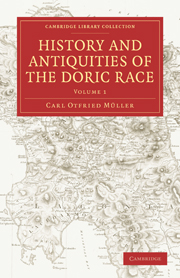Book contents
- Frontmatter
- THE TRANSLATORS' PREFACE
- Contents
- INTRODUCTION
- BOOK I HISTORY OF THE DORIC RACE, FROM THE EARLIEST TIMES TO THE END OF THE PELOPONNESIAN WAR
- CHAP. I
- CHAP. II
- CHAP. III
- CHAP. IV
- CHAP. V
- CHAP. VI
- CHAP. VII
- CHAP. VIII
- CHAP IX
- BOOK II RELIGION AND MYTHOLOGY OF THE DORIANS
- APPENDIX
- ADDITIONS AND CORRECTIONS
- Plate section
CHAP. VI
Published online by Cambridge University Press: 05 August 2011
- Frontmatter
- THE TRANSLATORS' PREFACE
- Contents
- INTRODUCTION
- BOOK I HISTORY OF THE DORIC RACE, FROM THE EARLIEST TIMES TO THE END OF THE PELOPONNESIAN WAR
- CHAP. I
- CHAP. II
- CHAP. III
- CHAP. IV
- CHAP. V
- CHAP. VI
- CHAP. VII
- CHAP. VIII
- CHAP IX
- BOOK II RELIGION AND MYTHOLOGY OF THE DORIANS
- APPENDIX
- ADDITIONS AND CORRECTIONS
- Plate section
Summary
The settlements of the Dorians without the Peloponnese.
1. On account of the multiplicity of subjects which it will be now necessary to consider, we shall be compelled to shorten the discussion of several points, and to take for granted many collateral questions, except where we may be encouraged to enter into greater detail by the hope of disclosing fresh fields for the inquiries of others.
It will be the most convenient method to make the mother-states the basis of our arrangement, as these are known with far greater certainty than the dates of the foundation of their respective colonies; by which means we shall also be enabled to take in a regular order those settlements which lie near to, and were connected with, one another.
First, the colonies of Argos, Epidaurus, and Trœzen. We will treat of these together, as they all lie in the same direction, and as the colonies of the two last states more or less recognised the supremacy of Argos, and not unfrequently followed a common leader. These extend as far as the southern extremity of Asia Minor.
The Dorians on the south-western coast of Asia Minor derived their origin, according to Herodotus, from the Peloponnese. And indeed they were generally considered as an Argive colony (from which state Strabo derives Rhodes, Halicarnassus, Cnidus, and Cos), led by princes of the Heraclidæ, from whom the noble families of Rhodes, for example the Eratidæ or Diagoridæ at Ialysus, claimed to be descended.
- Type
- Chapter
- Information
- History and Antiquities of the Doric Race , pp. 117 - 147Publisher: Cambridge University PressPrint publication year: 2010First published in: 1830



